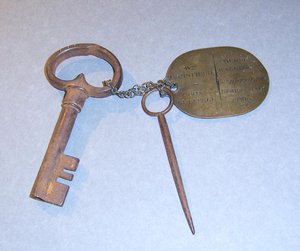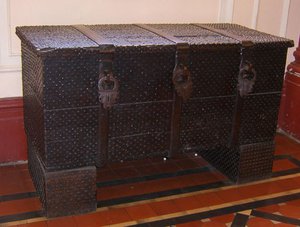
Alleyn keys
During the summer of 1605, at the age of 38, Edward Alleyn began to negotiate with Sir Francis Calton, a member of a prominent City goldsmith’s family who was knighted in 1605 and became Lord Mayor in 1612, for the manor of Dulwich, including ‘the wodes upon the waste’. Calton’s grandfather Thomas had been given a lease of the manor at Dulwich by Letters Patent from Henry VIII in 1544, and Sir Francis had inherited it at the age of ten in 1575. On October 3, Alleyn bought the manor for £5,000 (£717,568 in today’s money), agreeing payments over seven years; on the back of the document Alleyn wrote notes of his financial resources, including his share of theatrical wardrobe, worth £100. A Deed of Sale of 1606 includes Camberwell and its advowson (i.e., the right of choosing the vicar). In 1606 Alleyn is styled Lord of the Manor of Dulwich: he sold another of his manors, at Kennington, to Calton for £2,000 in 1609.
Alleyn bought further acres and messuages (i.e., houses) on the Dulwich estate from Sir Edmond Bowyer, a Dulwich resident who was sheriff of Surrey in 1600 and its Member of Parliament in 1603, and more from Calton in the years 1606-14. Eventually the estate amounted to 1,100 acres and extended, as it does today, from Denmark Hill to what are now the Crystal Palace grounds on Sydenham Hill, in between the ‘Lordships’ Lane (indicating the manorial boundary) on the east and Croxted (meaning ‘crooked street’) Lane on the west. Until about 1614 Alleyn is believed to have remained resident at Bankside, where letters are addressed to him, but after this date he began to be habitually styled as ‘Edward Alleyn of Dulwich, Esquire’.

Alleyn chest
Alleyn thought first of founding a Hospital (presumably on account of the Plague), but next proposed to commemorate himself by a Foundation to be called ‘Alleyn’s College of God’s Gift’. This Foundation was to be in two parts: one charitable (or ‘eleemosynary’) and the other educational, on one site, and sharing a chapel. The College was designed by Alleyn to benefit the four parishes associated with his career: St Botolph’s, Bishopgate (where he grew up, and where he still owned property and had endowed almshouses); St Giles, Cripplegate (where the Fortune theatre lay just outside the City), which from 1773 by a boundary change became St Luke’s, Finsbury; St Saviour’s Southwark, near the Bankside (the site of his house, as well as the Rose, Bear Garden and Hope theatres); and St Giles, Camberwell (which included the manor of Dulwich). Three 'poor scholars' were to join the College from each parish, along with three 'poor brethren' or 'sisters'. The Poor Scholars, aged between six and eighteen, were to be educated by resident Fellows.
From his letters to Calton, it is clear that Alleyn felt that he had been denied the opportunity of advanced education: a draft letter apologises that he cannot reply in the same style, saying that he writes himself ‘now with so much scholarship for I Have none at all’. Alleyn could not have been blind to the effect of education and culture on his successful contemporaries: it is even possible that he was inspired by the glittering theatrical career of the playwright Christopher Marlowe, the author of Alleyn’s most celebrated roles. Marlowe rose by the type of charitable patronage envisioned by Alleyn, which was not only intended to school his Poor Scholars but to send them to university with scholarships from the College.
For the architecture and constitution of the College of God’s Gift, Alleyn followed a Dutch prototype, that of the Orphanoconium and Gerontocomium at Amsterdam, a group of almshouses for young and old founded in 1530 and formed around a courtyard; he had a transcript of their statutes. Alleyn visited schools and hospitals in England to study statutes and syllabuses, and also the catering arrangements. The course of instruction was to follow that of the ‘free grammar Scholes of Westminster and St. Paules’. He investigated the syllabus at Dean Colet’s St Paul’s, which he visited twice. The speech days he wished to be modelled on those at Westminster and Merchant Taylors. Eventually it was decided that the boys were to study ‘good and sound learning, writing, reading, grammar, musique and good manners’. This curriculum was to include ‘the rule and precepts of the grammar allowed in England’.
The College’s statutes, plate and ready money were to be kept in Alleyn’s massy oak ‘comon chest’, dated 1616, clamped with great iron bands and studded with great iron nails, in the treasure chamber above the ‘great porch’ in the tower. Restored in 1879, it stands today in the Lower Hall at the new College (built in 1858 on a site a half mile from the original College). The elaborate statutes for the smooth running of the College included not only educational guidelines but the uniform for scholars—an uppercoat of ‘good cloth of sad color’ and black caps--as well as arrangements for laundry and the hiring of a ploughboy. The diet was to consist of loaves, boiled beef, cheese, fish, with apple and pear pies; all of this was to be increased on ‘gawdy daies’, and on three days a week the poor scholars were to have ‘beere without stint’. The pensioners had chores of sweeping and weeding, and one was to act as Matron for the schoolboys. There was a stocks as penalty for drunkenness, situated by the gates of the Old College on the former village green. There was to be no gambling, and no weapons were to be kept in the College.
In May 1613 Alleyn settled with John Benson of Westminster to construct ‘a certaine building of brick’ for ‘a chappell, a scholehowse and twelve almshowes’ (Muniment 3, mun-1/003/01r). The chapel was built before the rest of the College as if for its symbolism at the heart of the College, and was consecrated and dedicated on Alleyn’s fiftieth birthday, September 1, 1616. The Archbishop of Canterbury performed the ceremony. Meanwhile, construction on the school and almshouses continued until 1619.
The Foundation was not formally constituted until June 21, 1619, when James I signed the Letters Patent. This document gave Alleyn authority to set his statutes and established both branches of the charity as ‘one Body Corporate and Politiq and one perpetual Coyminallty to have perpetuall succession for ever to endure’. On September 13, 1619, the great actor read aloud his Deed of Foundation (Muniment 584, mun-3/584/01r) in the College Chapel and hosted a celebratory dinner for its signatories, including Sir Francis Bacon (the Chancellor, Lord Verulam), Thomas Howard (Earl of Arundel) and Inigo Jones (the King’s Surveyor and a distinguished architect, whose plans may have featured in the design for Dulwich College). Reconstituted by an Act of Parliament as a school mostly for fee-payers in 1856, and soon outdoing famous ‘Public Schools’, Dulwich College continues with Scholarships to commemorate the noble aspirations of its founder, Edward Alleyn.
For further discussion, see the digital essays ‘The Foundation Deed of Dulwich College’ and ‘The Diary of Edward Alleyn’ as well as the book Dulwich College: a History, 1616-2008, by Jan Piggott (London: Dulwich College, 2008).